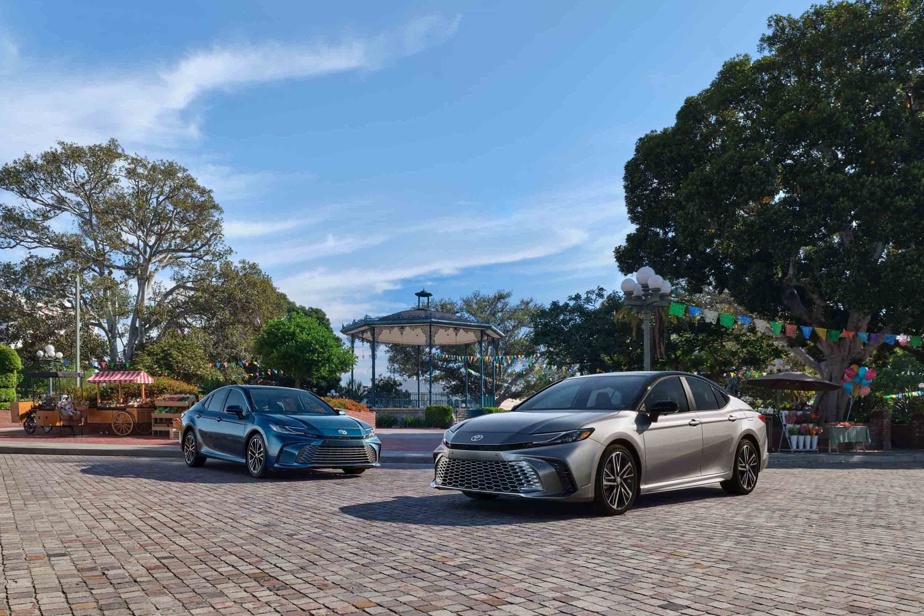Faced with the flood of SUVs, the commercial erosion of the car (sedan, coupe and convertible) is hardly surprising. The Camry, which was the best-selling car in North America for nearly a quarter of a century, is not the only one feeling down. But rather than throwing in the towel, Toyota is back in business. The 9e generation of the Camry is not only in tune with the times, but also exclusively uses hybrid power.
The 2018 redesign didn’t give the Camry much new life, but it still marked a break with the rather cheesy appearance of previous generations. The newcomer, for its part, sports a front end that is both more elegant and less tormented than before. In fact, this time it looks like that of a Prius.
Apart from a handful of millimetres in length, the exterior dimensions have not changed. The same goes for the interior and utility (trunk) volumes. Still the same. No one will complain about these aspects. No doubt partly because of the scarcity of supply in the segment. That said, entry, as well as exit from the rear seats, requires a little flexibility due to the profile of the roof and doors that open a little too narrowly.
The new feature, since there is one, mainly concerns the interior presentation, more particularly the dashboard.
This one now has a protrusion that connects the center console tray to the right door panel. Covered in fabric, this flourish creates the impression for the front passenger of being isolated from the other occupants. Just above, we see a series of thin black slats of glossy plastic. These give the illusion of being an extension of the air vent placed near the door. It’s up to you to like it or not! There is, however, one aspect that everyone will agree on: the infotainment screen is not a catch-all. There are controls, switches and buttons on board this Camry. And that’s a good thing, since they are much less distracting. Toyota’s initiative must be applauded here.
The front seats provide acceptable comfort. The seats lack relief and the backrests, camber. On the other hand, the driving position is easy to find because of the many adjustments and a steering column that adjusts on two axes. In the back, two people, not three, will travel comfortably.
Change while remaining the same
Since it is no longer as widely distributed as it once was, the Camry has reduced the nomenclature of its range to its simplest expression. On the technical level, at least. Only one engine (hybrid) and one gearbox (CVT) are listed in the inventory of technical characteristics of this model, regardless of the version chosen.
At the entry level, Toyota includes a towed version – the only one – in its catalog. This one is rather well equipped (sunroof as standard), but does without certain active safety elements (lane departure warning, for example) which are not essential, to tell the truth. It is a safe bet that the size (8 inches instead of 12.3 inches) of the infotainment screen will be the biggest disappointment for buyers of this version. There are also the tires (16 inches), less expensive to replace, but certainly not as efficient and steerable as the 18 and 19 inches offered on the SE Upgrade, XSE and XLE versions.
That said, if the main thing is to buy a mid-size family sedan that is economical at the pump and in use, the SE (front-wheel drive) remains the wisest choice.
By opting for one of the other versions, the buyer will benefit from slightly sharper road handling and more direct steering. Better balance too (reduced understeer, in particular), particularly noticeable in tight bends. For the rest, it’s pretty much the same thing – apart from the accessories, of course.
The Camry is an unsurprising road car, easy to handle. Stable, quiet and well damped. The consumption claimed by the manufacturer seems extraordinary (5.1 L/100 km), but in reality, we were not able to repeat this performance on the roads of La Belle Province. At best, we managed to obtain 5.6 L/100 km. The gasoline and electric engines work in perfect symbiosis. It is only during strong accelerations that the thermal part shows its bad mood in concert with the continuously variable transmission which seems at the end of its rope (sorry, its belt). A short-lived inconvenience.
Toyota Camry
- Price range: $37,181.50 to $47,831.50
- Consumption: 4.9 L/100 km (front-wheel drive), 5.1 L/100 km (all-wheel drive)
- CO emissions2 : 114 g/km (front-wheel drive), 117 g/km (integrated)
Visit the Toyota website
We like
- Ride comfort
- Safe bet
- Amazing consumption
We like less
- Rear access and exit
- Only the appearance is sporty; the behavior is not so much.
- Noisy engine when working
Our verdict
“Polish it constantly, and polish it again,” wrote Nicolas Boileau (1636-1711). Toyota applies this with the Camry.
Share your experience
The Press will soon be publishing reviews of the following vehicles: Chevrolet Equinox EV, Fiat 500e, Honda Civic (Hybrid), Mini Countryman, Nissan Sentra, and Subaru BRZ. If you own one of these vehicles or are waiting for one to be delivered, we would love to hear from you.
Write to us to share your experience
